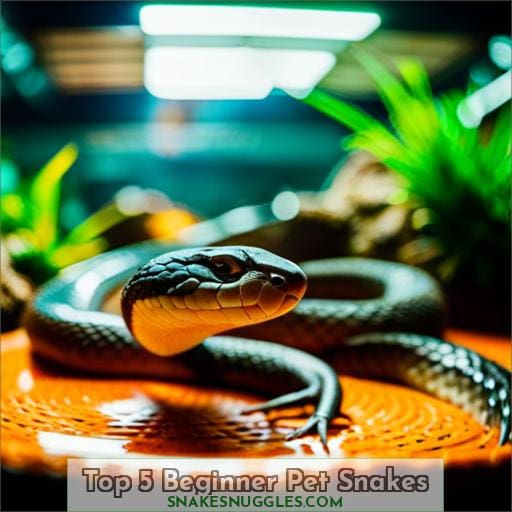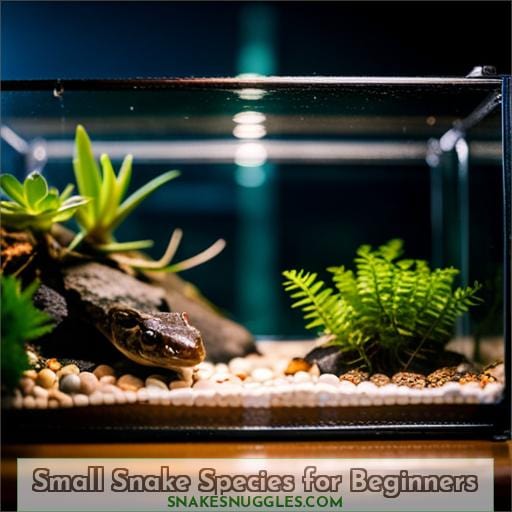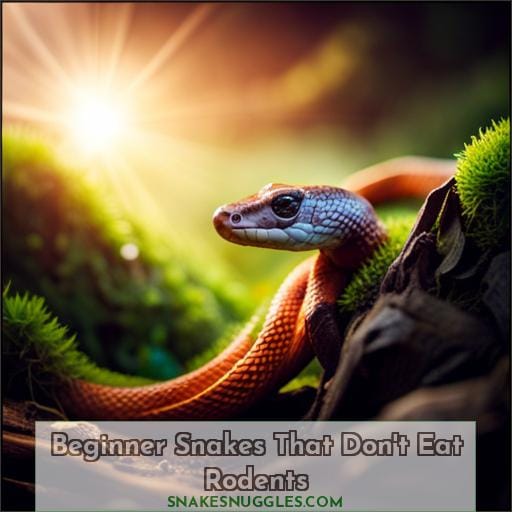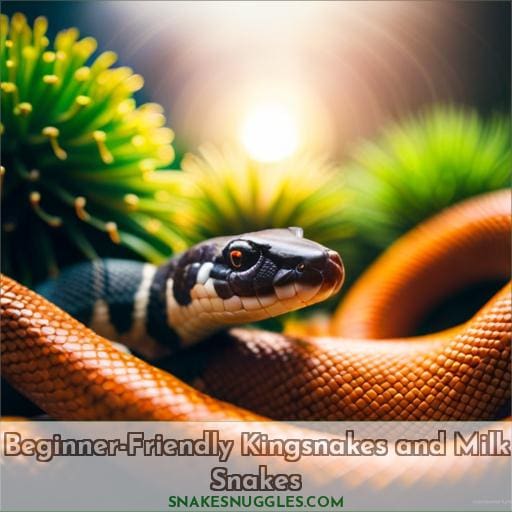This site is supported by our readers. We may earn a commission, at no cost to you, if you purchase through links.
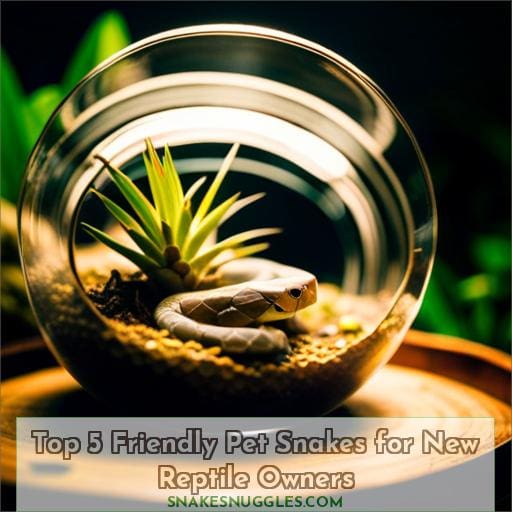 You’ve considered bringing a slithery friend into your home, but don’t know where to start.
You’ve considered bringing a slithery friend into your home, but don’t know where to start.
Selecting the right snake species is key for first-time reptile owners.
We’ve compiled prime picks that prioritize docile temperaments over impressive lengths.
Whether you prefer tiny serpents or heftier handfuls, discover top recommendations ideal for beginners ready to welcome their inaugural scaly pet.
Table Of Contents
- Key Takeaways
- Top 5 Beginner Pet Snakes
- Friendly Snakes You Can Handle
- Small Snake Species for Beginners
- Beginner Snakes That Don’t Eat Rodents
- Beginner-Friendly Kingsnakes and Milk Snakes
- Easy Care for Ball Pythons
- Start With Docile Species
- Choose the Right Enclosure
- Frequently Asked Questions (FAQs)
- Conclusion
Key Takeaways
- Corn snakes and ball pythons are classic starter snakes that are docile, readily available, and have straightforward care.
- Rosy boas and milk snakes also make good beginner snakes. They have calm temperaments and come in a variety of color morphs.
- Smaller snakes like corn snakes, rosy boas, and garter snakes are easier to handle and require simple enclosures.
- Kingsnakes and milk snakes have colorful varieties and are typically calm when handled gently on a regular basis.
Top 5 Beginner Pet Snakes
Out of the many snake species to choose from for a new herp enthusiast, the top 5 that stand out as beginner pet snakes are:
- Corn snake
- Ball python
- Rosy boa
- Milk snake
- Kingsnake
These snakes are chosen due in part to their general ease of care, moderate size potential, and typically docile dispositions when habituated to handling.
Corn snakes come in a variety of color morphs, have simple feeding habits and enclosure needs, and can live 20+ years.
Ball pythons are docile, have easy handling techniques, a lifespan around 30 years, and are available in many color varieties.
Rosy boas have mild temperaments, straightforward enclosure setups, and can thrive on a diet of frozen/thawed mice.
Milk snakes and kingsnakes are active yet typically tolerate handling, have simple feeding requirements on rodents, and color variations that make them unique captives.
Friendly Snakes You Can Handle
With their mild temperaments, ball pythons and rosy boas make for friendly pet snakes that you’ll enjoy handling.
When interacting with these docile species, utilize proper handling techniques like supporting their bodies and avoiding constricting their necks.
Gain behavioral insights through regular but brief handling sessions to habituate them to contact.
Providing ideal environments like proper hides and temperatures fosters security.
Use interaction tips like moving slowly and deliberately until they’re comfortable being handled.
Understanding temperament traits like ball pythons’ shy nature means respecting their space when needed.
With patience and the right approach, friendly snakes that enjoy handling enrich the beginner snake owner’s experience.
Incorporating species-specific knowledge lets you confidently and safely handle even adult ball pythons and rosy boas.
Small Snake Species for Beginners
When choosing your first pet snake, consider small, docile species that stay modest in size.
Corn snakes and rosy boas are two excellent starter options, averaging only 2-4 feet as adults, making them easier to handle and house.
Their calm demeanors also make them more enjoyable to interact with.
Corn Snakes
You’ll find corn snakes to be hardy, docile captives that rarely present feeding issues or health problems.
As a top beginner pet snake, corn snakes have:
- Easy handling – they rarely bite and tolerate gentle handling.
- Diverse color varieties – selectively bred for vibrant red, orange, and yellow patterns.
- Simple breeding – no special conditions needed, good for new breeders.
- Flexible feeding – readily accept frozen/thawed mice on a weekly schedule.
Kept alone or in breeding groups, corn snakes thrive with proper heating, humidity, hides, and enrichment.
Rosy Boas
These docile, small snakes are another one of the best options for beginners.
Rosy boas have a lifespan exceeding 20 years when properly cared for.
Their habitats should contain hides, branches, and appropriate substrate.
They only need to eat an appropriately-sized mouse every 7-10 days.
When handled gently, rosy boas rarely bite.
Their color morphs range from sandy to pink.
Overall, rosy boas are a friendly pet snake well-suited for new reptile owners.
Beginner Snakes That Don’t Eat Rodents
You may wish to consider a garter snake or green snake.
Both are good starter snakes that primarily eat insects, fish, or worms instead of rodents.
This makes them a unique alternative to traditional beginner pet snakes.
Garter Snakes
Garter snakes require you to not feed them mice or rats. Instead, offer them fish, worms, tadpoles, or small frogs.
When handling garters, support their body to prevent injury.
Select from the many color varieties, providing an appropriately sized enclosure with hiding spots.
Feed a varied diet, as garters enjoy hunting.
Their active nature and small size make them a lively, unique snake that avoids aggression.
As a friendly species ideal for new owners without rodents, garter snakes can be a rewarding first pet snake.
Green Snakes
Frequently, you’re better off starting with green snakes that typically eat insects rather than rodents.
These petite, docile, arboreal snakes thrive in naturalistic vivariums with climbing branches and ample foliage.
Offer variety in their insectivorous diet and provide proper temperatures for their tropical origins.
When handling, gently support their bodies as they’re fragile.
Though small, green snakes exhibit delightful behaviors like peering from leaves which enrich their captive environment.
Through proper care and husbandry, breeding attempts often s쳮d, continuing healthy captive populations.
Beginner-Friendly Kingsnakes and Milk Snakes
You’re also keen on kingsnakes and milk snakes for rookies since they’re typically calm and readily available at reptile shows and pet shops.
Colorful Varieties
- Scarlet kingsnake
- Sinaloan milk snake
- Pueblan milk snake
Handling Tips
- Move slowly
- Support their body
Habitat Setup
- Aspen shavings substrate
- Hides on warm and cool sides
- Frozen/thawed rodents (mice) every 5-7 days
With proper care, kingsnakes and milk snakes can live 10-15 years.
Easy Care for Ball Pythons
The ball python is your easiest beginner snake to care for.
Monitor the heat so the temperature in the enclosure stays between 80-90°F using a thermostat connected to a heat mat or ceramic heat emitter.
Offer a variety of frozen/thawed mice or rats and give the snake access to fresh water.
Provide two hide boxes, one on the warm side and one on the cooler side, so the snake can thermoregulate.
Mist the snake with water and provide a humid hide box during shedding.
Allow the snake to soak in a water bowl or explore enrichment items like branches and tunnels.
Handle the snake gently and consistently so it becomes comfortable with you.
With proper husbandry, a ball python makes an excellent, long-lived pet snake.
Start With Docile Species
When choosing your first pet snake, you’ll want to start with docile species that are unlikely to bite or exhibit aggressive behavior.
Establish an understanding of ideal handling techniques, temperament traits, taming methods, and habitat setup to ensure a peaceful interaction.
Approach initial handling attempts slowly with confidence – allow the snake to become accustomed to your scent before lifting.
Be alert to body language cues that signal fear or stress.
Utilize a hook to transfer the snake when space permits.
Consistent, gentle sessions build trust over time.
Research species with a reputation for tolerance; select based on your comfort level interacting.
Invest preparation dispelling myths; reality often calmer than perceived.
Allow innate curiosity about these fascinating creatures to motivate an intimate, rewarding companionship.
Choose the Right Enclosure
Choosing the right enclosure is critical for keeping pet snakes healthy and safe.
Make sure to select an enclosure of appropriate size for the species, with proper substrate and accessories.
You’ll also need to maintain the proper ambient temperature range and humidity level.
Appropriate Size Critical
One key factor when choosing an enclosure for your pet snake is ensuring it’s of an appropriate size.
Size Matters when providing proper Habitat Essentials.
Choose an enclosure that allows your snake to fully stretch out and move around comfortably based on its Lifespan Insights and projected adult size.
An enclosure that’s too small increases stress and aggression.
Follow Handling Tips and Feeding Guidelines adjusted to your snake’s size.
Substrate And Accessories
With careful consideration of substrates and accessories, you’ll choose the proper setup for the enclosure.
Evaluate substrate options like newspaper, aspen shavings, or reptile carpet.
Add enrichment ideas like branches, foliage, and hides.
Include decor essentials like thermometers, hygrometers, and water bowls.
Use misters or moist hides for humidity control.
Follow cleaning tips like spot cleaning, full substrate changes, and disinfecting decor.
Maintain Proper Temperature
You’ll need to maintain proper temperatures within the enclosure to keep your pet snake healthy and comfortable.
Use a reliable thermostat and thermometer to monitor the temperature gradient.
The warm end should be around 80-85°F and the cool end around 70-75°F for most species.
Place the thermostat’s probe and heat source on the warm end to control temperatures.
Provide a thermal gradient using under tank heaters or overhead heat lamps.
Monitor and adjust as needed so your snake can properly thermoregulate.
Frequently Asked Questions (FAQs)
What are the basic housing requirements for a beginner pet snake?
You’ll need:
- An appropriately sized enclosure with a secure screened top
- Substrate
- Hide box
- Water bowl
- Climbing branch
Maintain proper temperature and humidity.
Thoroughly clean and sanitize the cage regularly.
Size up the enclosure as the snake grows.
How often and what temperatures should I feed a new pet snake?
Feed hatchlings 1-2 times per week and adults every 5-7 days.
Offer food when the snake is active and hungry at night.
Feed frozen/thawed rodents warmed to above room temperature.
What handling precautions should I take with a new snake?
Approach slowly and confidently with clean hands.
Let the snake become accustomed to your presence and scent before attempting to handle.
Support its body fully when lifting and move steadily to avoid startling it.
Where can I buy a healthy pet snake as a beginner?
Visit local reptile expos, which host numerous vendors offering healthy snakes at fair prices.
Reputable breeders also provide quality specimens.
Research sellers and inspect animals thoroughly before purchase.
Quarantine new snakes for health and temperament.
What signs of illness should I watch for in a new pet snake?
Watch for lethargy, refusal to eat, unusual shedding, visible injuries, and discharge from the mouth or cloaca.
Check their environment for proper temperatures, humidity, and cleanliness.
Consult an exotic vet if issues persist.
Conclusion
Let these friendly snakes slither into your heart.
For first-time reptile owners, choose docile species that prioritize calm temperaments over impressive lengths.
With proper enclosures and care, small snakes like corn snakes and rosy boas make excellent starter pets.
Their manageable sizes and mellow manners create rewarding bonds between you and your new slithery friend.
When starting out, opt for beginner-friendly top 5 best snakes that ease novice owners into the reptile hobby.

